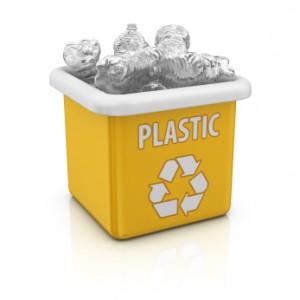 Last week we challenged you to familiarize yourself with your local recycling programs. This installment of our America Recycles Day blog series is another recycling challenge – to know your recyclable materials beginning with plastic.
Last week we challenged you to familiarize yourself with your local recycling programs. This installment of our America Recycles Day blog series is another recycling challenge – to know your recyclable materials beginning with plastic.
According to the Container Recycling Institute, more than 60 million plastic bottles end up in landfills and incinerators daily. So, think before you trash that empty water bottle.
Top 10 Reasons to Recycle Plastic Bottles
(from Earth911.com)
1. Shed some light on the issue. Recycling a single plastic bottle can conserve enough energy to light a 60-watt light bulb for up to six hours.
2. It’s a growing demand. According to the EPA, the amount of plastics generation in municipal solid waste has increased from less than 1 percent in 1960 to 12.1 percent in 2007.
3. Get a creative boost. Recycled plastic bottles can be made into products such as clothing, carpeting, detergent bottles and lumber for outdoor decking.
4. Walk it out. More than 80 percent of U.S. households have access to a plastics recycling program, be it curbside or community drop-off centers.
5. Get on the bandwagon. In recent years, the number of U.S. plastics recycling business has nearly tripled. More than 1,600 businesses are involved in recycling post-consumer plastics.
6. Make room. Recycling one ton of plastic saves 7.4 cubic yards of landfill space.
7. It’s getting hotter. Recycling one pound of PET plastic bottles saves approximately 12,000 BTUs (British thermal unit) of heat energy.
8. Reduce the use. Producing new plastic products from recycled materials uses two-thirds less energy than is required to make products from raw (virgin) materials. It also reduces greenhouse gas emissions.
9. Salvage what’s left. According to the EPA, while overall recovery of plastics for recycling is relatively small – 2.1 million – recovery of some plastic containers has reached higher levels. PET soft drink bottles were recovered at a rate of 37 percent in 2007. Recovery of HDPE milk and water bottles was estimated at about 28 percent in 2007.
10. Push it forward. Plastics are a rapidly growing segment of the municipal solid waste stream. The largest category of plastics are found in containers and packaging (e.g., soft drink bottles, lids, shampoo bottles).
We know it’s not always easy to recycle those plastic containers, sometimes due to confusion over what type of plastic is recyclable or because you’re out and about and can’t find a recycle bin. Here are a few tips to help make recycling plastic containers a little easier.
- Check plastic bottle types and numbers. Make sure to find out which plastic bottles are accepted for recycling in your area. Many programs collect plastic bottles made from PET (#1) and HDPE (#2), which together represent almost 96 percent of all plastic bottles produced in the U.S., including milk jogs, water, soft drink, juice bottles, shampoo, toiletries, laundry detergent, household cleaners, salad dressings and other food jars.
- Rinse bottles before tossing them into the bin. Labels are also generally okay. While it has always been recommended to remove bottle caps, keep the cap on unless specifically noted otherwise in your curbside program. Make sure to not throw the cap in separately as it may get lost in the transportation process and become litter.
- Bring it home. When you’re out and about and have a plastic bottle, bring it home for recycling if there are no recycling options around you. Simply leave it in your car, purse or briefcase.
- When in doubt, leave it out. In addition to bottles, a growing number of communities are collecting and recycling plastic containers, such as tubs, trays and lids. But keep in mind that mixing the wrong types of materials can lower the quality of the recycled material. So make sure you understand what types of containers your program accepts.
Hopefully this article sheds some light on recyclable plastics and helps encourage you to recycle more plastic bottles and containers. Next up, paper!
Challenge #3: Know Your Recyclables, Paper
According to the Environmental Protection Agency, paper accounts for an estimated 33 percent of municipal solid waste, more than any other material Americans throw away. Learn how Pratt Industries helps to divert 1.8 million tons of paper waste from the landfill in the next article of our Recycling Blog Series.